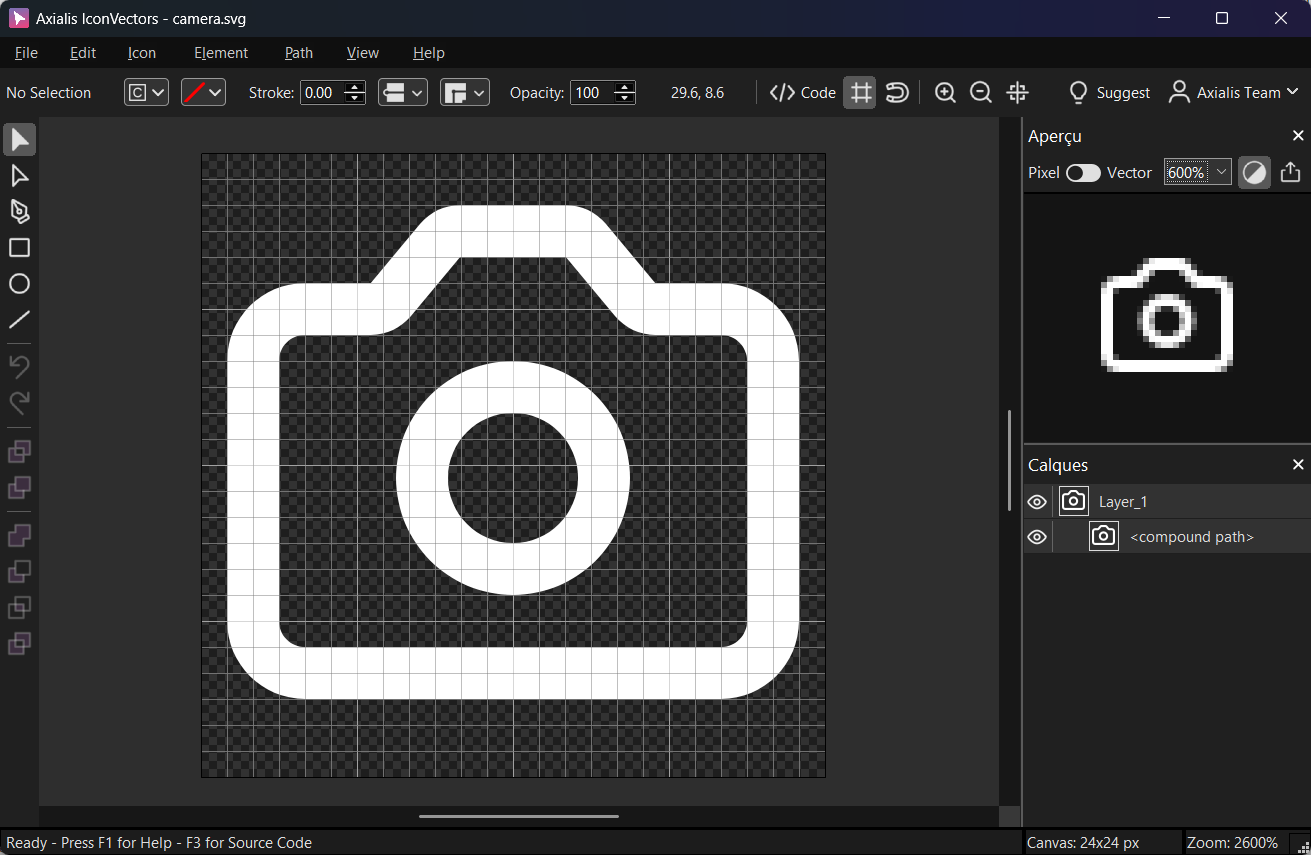Build an SVG Sprite for Vite/React/Vue (CLI & plugin routes)

Sprites let you ship one cached SVG file containing many icons. Below you’ll export clean per‑icon SVGs in Axialis IconVectors, then generate a symbol sprite two ways: with a Vite plugin or an NPM CLI. Finally, you’ll reference icons via <use> and cover caching/compat notes.
Export clean per‑icon SVGs from IconVectors
- Open or create your icons:
- File → Open… (Ctrl+O) or New Icon (Ctrl+N).
- Prefer currentColor paints and a tidy
viewBox(e.g.,0 0 24 24). - File → Export → Export Minified (Shift+Ctrl+M) for lean SVGs (SVGO‑friendly).

Keep one icon per file in src/icons/, named consistently (e.g.,check.svg,alert.svg).
Route A — Vite plugin (auto sprite for React/Vue)
- Install the plugin:
npm i -D vite-plugin-svg-icons # or: pnpm add -D vite-plugin-svg-icons # or: yarn add -D vite-plugin-svg-iconsThis plugin scans your
src/iconsfolder, builds a symbol sprite, and injects it at runtime. Configure SVGO and a stablesymbolIdpattern. - Configure
vite.config.tsimport { defineConfig } from 'vite' import vue from '@vitejs/plugin-vue' // or: import react from '@vitejs/plugin-react' import { createSvgIconsPlugin } from 'vite-plugin-svg-icons' import path from 'path' export default defineConfig({ plugins: [ // vue(), or react(), createSvgIconsPlugin({ iconDirs: [path.resolve(process.cwd(), 'src/icons')], symbolId: 'icon-[dir]-[name]', svgoOptions: { plugins: [ { name: 'preset-default', params: { overrides: { removeViewBox: false } } }, 'removeDimensions', 'prefixIds' // prevent ID collisions across icons ] }, inject: 'body-last' }) ] }) - Register sprite & use icons
// main.ts or main.tsx (React/Vue entry) import 'virtual:svg-icons-register'// React component export function Button() { return ( <button className="inline-flex items-center gap-2 text-blue-600"> <svg className="w-5 h-5" aria-hidden="true"> <use href="#icon-check" /> {/* symbolId = icon-[dir]-[name] */} </svg> Save </button> ) }<!-- Vue SFC snippet --> <template> <button class="inline-flex items-center gap-2 text-emerald-600"> <svg class="w-5 h-5" aria-hidden="true"><use href="#icon-check" /></svg> Save </button> </template>Note: Use
hrefon<use>. The olderxlink:hrefis deprecated; include it only as a fallback for legacy engines.
Route B — NPM CLI (build a static public/sprite.svg)
- Install the CLI:
npm i -D svg-spriteThe CLI can output multiple modes; pick symbol for web icons.
- Add a script that builds one sprite from all icons:
{ "scripts": { "build:sprite": "svg-sprite -s --symbol-dest public --symbol-sprite sprite.svg src/icons/*.svg" } }This compiles every SVG in
src/iconsintopublic/sprite.svg. Adjust paths as needed. - Reference icons in markup:
<!-- External sprite placed under /public --> <svg class="icon w-5 h-5" aria-hidden="true"> <use href="/sprite.svg#check" /> <!-- or: href="/sprite.svg#icons-check" if your tool prefixes --> </svg>- Caching: serve with far‑future cache headers; add a file hash or query (e.g.,
/sprite.abc123.svgor/sprite.svg?v=abc123). - Same‑origin: referencing an external sprite via
<use>typically requires same‑origin or correct CORS headers.
- Caching: serve with far‑future cache headers; add a file hash or query (e.g.,
When to pick which route
- Vite plugin: fastest DX, HMR updates, automatic injection; ideal for React/Vue SPAs.
- CLI: a single static file you can reuse across stacks (SSR, static sites, CMS). Great where you control build scripts.
IconVectors tips
- Minify and keep viewBox. Use File → Export → Export Minified (Shift+Ctrl+M).
- Theming: set
fill="currentColor"/stroke="currentColor"so icons inherit text color. - IDs: if your icons have
id/gradients, enable an SVGO prefixIds pass (shown above) to avoid collisions in the combined sprite.
Troubleshooting
- Icon not found — confirm the generated
symbolId(plugin option) or the sprite’s<symbol id="...">names from the CLI output. - Colors don’t change — ensure paths use
currentColoror overridefill/strokein CSS on the wrapper<svg>. - Legacy href — if supporting older browsers, add both
hrefandxlink:hrefon<use>; modern browsers usehref.
Start Making SVG Icons Today with IconVectors
Download the fully-functional 30‑Day Free Trial and unlock your icon design workflow.
Version 1.10 - September 17, 2025

